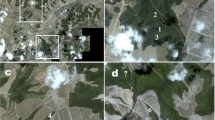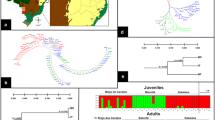Abstract
Idiospermum australiense (Diels) S.T. Blake is considered to be one of the few remaining species of an ancient assemblage to have survived the attrition of Australian tropical rain forest during historically drier periods. This monotypic species is currently restricted to two very wet lowland rain forest locations in Australia’s wet tropical World Heritage Area that are thought to have provided refuge for humid-adapted taxa during the last glacial maximum. Two dominant (RAPD and ISSR) molecular marker sets were employed to investigate whether the genetic structure of Idiospermum could be attributed to its restriction to these quite disjunct localities. The results reveal that neither its restriction to purported Pleistocene refugia nor the geographic distance between populations could fully explain the distribution of variation in the Idiospermum data set, with evidence to suggest that potentially deeper time events have played a role in population structuring and the distribution of diversity. Although there is sufficient evidence in the data to suggest that gene dispersal is quite limited in the species, further investigation is still needed to yield more informative detail on additional factors, such as breeding and germination strategies and their potential influence over population structuring and diversity levels within each population and refugium.




Similar content being viewed by others
References
Allnutt TR, Newton AC, Lara A, Premoli A, Armesto JJ, Vergara R, Gardner M (1999) Genetic variation in Fitzroya cupressoides (alerce), a threatened South American conifer. Mol Ecol 8:975–987
Bekessy SA, Allnutt TR, Premoli AC, Lara A, Ennos RA, Burgman MA, Cortes M, Newton AC (2002) Genetic variation in the vulnerable and endemic monkey puzzle tree, detected using RAPDs. Heredity 88:243–249
Bell KL, Yeates DK, Moritz C, Monteith GB (2004) Molecular phylogeny and biogeography of the dung beetle genus Temnoplectron Westwood (Scarabaeidae: Scarabaeinae) from Australia’s wet tropics. Mol Phylogen Evol 31:741–753
Bussell JD, Waycott M, Chappill JA (2005) Arbitrarily amplified DNA markers as characters for phylogenetic inference. Perspect Plant Ecol Evol Syst 7:3–26
Doyle JJ, Doyle JS (1987) A rapid DNA isolation procedure for small quantities of fresh leaf tissue. Phytochem Bull 19:11–15
Duke RK, Allan RD, Johnston GA, Mewett KN, Mitrovic AD (1995) Idiospermuline, a trimeric pyrrolidinoindoline alkaloid from the seed of Idiospermum australiense. J Nat Prod 58:1200–1208
Dutech C, Maggia L, Tardy C, Joly HI, Jarne P (2003) Tracking a genetic signal of extinction-recolonization events in a neotropical tree species: Vouacapoua americana Aublet in French Guiana. Evol 57:2753–2764
Edwards W, Gadek P, Weber E, Worboys S (2001) Idiosyncratic phenomenon of regeneration from cotyledons in the idiot fruit tree, Idiospermum australiense. Aust Ecol 26:254–258
Esselman EJ, Jianqiang L, Crawford DJ, Winduss JL, Wolfe AD (1999) Clonal diversity in the rare Calamagrostis porteri ssp. insperata (Poaceae): comparative results for allozymes and random amplified polymorphic DNA (RAPD) and intersimple sequence repeat (ISSR) markers. Mol Ecol 8:442–451
Frankham R (1996) Relationship of genetic variation to population size in wildlife. Conserv Biol 10:1500–1508
Frankham R, Ballou JD, Briscoe DA (2004) A primer of conservation genetics. Cambridge University Press, Cambridge
Goosem S (2002) Update of original Wet Tropics of Queensland Nnomination dossier. Wet Tropics of Queensland World Heritage Area, September 2002. Wet Tropics Management Authority, Cairns
House S, Moritz C (1991) The impact of rain forest fragmentation on flora and fauna. In: Goudberg N, Bonell M, Benzarken D (eds) Tropical rain forest research in Australia: present status and future directions for the Institute of tropical rain forest studies: proceedings of a workshop held in Townsville, Australia, 4–6 May 1990. Institute for Tropical Rainforest Studies, Townsville, pp 115–125
Hugall A, Moritz C, Moussalli A, Stanisic J (2002) Reconciling paleodistribution models and comparative phylogeography in the Wet Tropics rain forest land snail Gnarosophia bellendenkerensis (Brazier 1875). Proc Natl Acad Sci USA 99:6112–6117
Kosman E, Leonard KJ (2005) Similarity coefficients for molecular markers in studies of genetic relationships between individuals for haploid, diploid, and polyploid species. Mol Ecol 14:415–424
Loveless MD, Hamrick JL (1984) Ecological determinants of genetic structure in plant populations. Annu Rev Ecol Syst 15:65–95
McCune B, Grace JB (2002) Analysis of ecological communities. MJM, Gleneden Beach
Nott JF (2003) The urban geology of Cairns, Queensland, Australia. Quat Int 103:75–82
Nybom H (2004) Comparison of different nuclear DNA markers for estimating intraspecific genetic diversity in plants. Mol Ecol 13:1143–1155
Nybom H, Bartish IV (2000) Effects of life history traits and sampling strategies on genetic diversity estimate obtained with RAPD markers in plants. Perspect Pl Ecol Evol Syst 3:93–114
Peakal R, Smouse PE (2005) GenAlEx 6: genetic analysis in Excel. Population genetic software for teaching and research. Mol Ecol Notes 6:288–295
Pye MG, Gadek PA (2004) Genetic diversity, differentiation and conservation in Araucaria bidwillii (Araucariaceae), Australia’s Bunya pine. Conserv Genet 5:619–629
Schneider CJ, Moritz C (1999) Rain forest refugia and evolution in Australia’s Wet Tropics. Proc R Soc B Biol Sci 266:191–196
Schneider CJ, Cunningham M, Moritz C (1998) Comparative phylogeography and the history of endemic vertebrates in the Wet Tropics rain forests of Australia. Mol Ecol 7:487–498
Schnieder S, Roessli D, Excoffier L (2000) Arlequin ver. 2000: a software for population genetics data analysis. Genetics and Biometry Laboratory, University of Geneva, Switzerland
Sork VL, Nason J, Campbell DR, Fernandez JF (1999) Landscape approach to historical and contemporary gene flow in plants. Trends Ecol Evol 14:219–224
Sydes MA, Peakall R (1998) Extensive clonality in the endangered shrub Haloragodendron lucasii (Haloragaceae) revealed by allozymes and RAPDs. Mol Ecol 7:87–93
Tero N, Aspi J, Siikamaki P, Jakalaniemi A, Tuomi J (2003) Genetic structure and gene flow in a metapopulation of an endangered plant species, Silene tatarica. Mol Ecol 12:2073–2085
Webb L, Tracy JG (1981) Australian rain forests, patterns and change. In: Junk W (ed) Ecological biogeography of Australia. Springer, The Hague, pp 607–694
Willmott WF, Stephenson PJ (1989) Rocks and landscapes of the Cairns district. Queensland Department of Mines, Brisbane
Wolfe AD, Xiang Q-Y, Kephart SR (1998) Assessing hybridization in natural populations of Penstemon (Scrophulariaceae) using hypervariable intersimple sequence repeat (ISSR) bands. Mol Ecol 7:1107–1125
Worboys SJ (1999) Pollination processes and population structure of Idiospermum australiense (Diels) S.T. Blake, a primitive tree of the Queensland Wet Tropics. PhD Dissertation, James Cook University
Worboys SJ (2003) Polycarpelly in Idiospermum australiense (Calycanthaceae). Austrobaileya 6:553–556
Worboys SJ, Jackes BR (2005) Pollination processes in Idiospermum australiense (Calycanthaceae), an arborescent basal angiosperm of Australia’s Tropical Rain Forests. Pl Syst Evol 251:107–117
Yeh FC, Yang RC, Boyle T, Ye ZH, Mao JX (1999) POPGENE ver 1.31: genetic data analysis software. Molecular Biology and Biotechnology Centre, University of Alberta, Canada
Zhou S, Renner SS, Wen J (2006) Molecular phylogeny and intra- and intercontinental biogeography of Calycanthaceae. Mol Phylogen Evol 39:1–15
Acknowledgments
We would like to acknowledge the traditional landowners of the areas in which Idiospermum australiense is located, the Ngadjonji, Matjandji and Yidindji, and the Kuku-yalangi people, respectively; Prue and Neil Hewitt for allowing us to collect material from their property; and Liana Joseph, Matthew Pye, Mary Gandini, Robert Jago, Brad Congdon, Michelle Waycott and Stuart Worboys for their assistance with this project. Thanks to Christopher Quinn, Stuart Worboys and Steve Goosem for their review of our manuscript. This project was made possible through joint funding received from the Australian Rainforest Collaborative Research Centre (Rainforest CRC, now disbanded) and James Cook University of North Queensland. Figure 1 incorporates data which is copyrighted to James Cook University (School of Tropical Environment Studies) and Commonwealth of Australia (Geoscience Australia) (2005).
Author information
Authors and Affiliations
Corresponding author
Rights and permissions
About this article
Cite this article
Jones, L.M., Gadek, P.A. & Harrington, M.G. Population genetic structuring in a rare tropical plant: Idiospermum australiense (Diels) S.T. Blake. Plant Syst Evol 286, 133–139 (2010). https://doi.org/10.1007/s00606-010-0293-2
Received:
Accepted:
Published:
Issue Date:
DOI: https://doi.org/10.1007/s00606-010-0293-2




